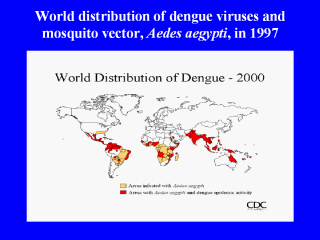 Click here to view the magnified slide.
Click here to view the magnified slide.
|
The human population is growing exponentially, with virtually all
of this growth occurring in urban zones. Compounding this problem, there is more
population movement between urban centers within and among countries, more
substandard housing, more artificial disposable containers and governmental
services that are inadequate in these burgeoning urban centers. As a result of
these changes, the resurgence of Aedes aegypti (dengue fever) is presently much
greater than it has been in the past. Worldwide, up to 100 million people
annually are infected with dengue fever, mainly in tropical cities and urban
areas, while 2.5 billion people are at risk of infection.
Human mobility and intervention also can be important for
their role in introducing virus into susceptible populations. Increased air
travel between urban centers of the tropics has been cited as a factor
responsible for the increased frequency of dengue epidemics. The geographic
dissemination and endemic maintenance of dengue fever in the Americas and the
Caribbean depends on the continued introduction of virus into susceptible human
populations, spread within these populations, and low-level transmission during
non-epidemic periods. |
